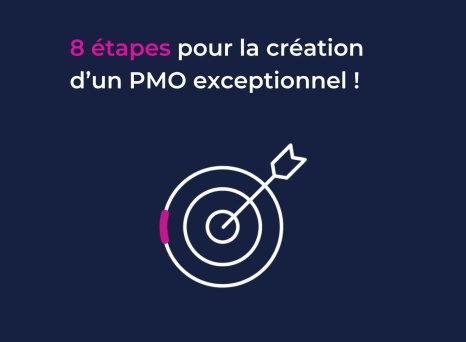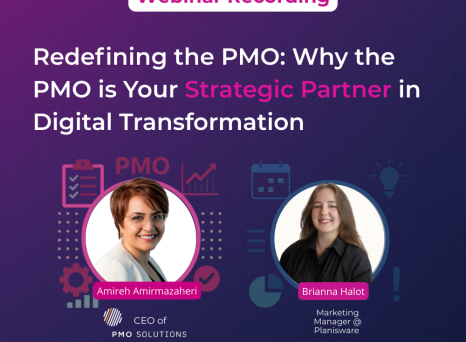What are the key markers of PMO maturity?
What are the key markers of PMO maturity?
Of course, there are many valid answers to this question. But one key indicator is the ability to keep projects aligned with strategic objectives. 94 percent of mature PMOs continually monitor project alignment, according to research by the Project Management Institute (PMI). That’s compared to just 38 percent of PMOs who do so overall.
This highlights the importance of the project portfolio management (PPM) methodology. By implementing PPM, you can build a powerful connection between top-level strategy and project delivery.
And for global businesses, PPM is even more valuable. With projects dispersed across locations, cultures, and timezones, maintaining integration with your core objectives requires consistent effort. PPM helps you shape and direct this effort effectively.
In this article, we’ll look at the benefits of PPM from the perspective of global businesses. We’ll show how PPM can help you aggregate insights from across your business. And, in turn, help unite your local and global project management strategies.
Continuous Improvement in Project Portfolio Management
PPM is not a static set of practices — and this is key to its importance for global businesses. Instead, PPM is a process of continuous improvement.
As each project unfolds, it generates insights you can apply to subsequent projects. This is true regardless of a project’s success. Indeed, even killed projects have lessons to offer.
Through these incremental, iterative improvements, you can achieve:
- Effective benchmarking. Completed projects provide extensive data on your organization’s performance. And that data is especially easy to use and act on if you use project management software. This data can help you tailor your KPIs and provide more accurate timelines for subsequent projects.
- Increased efficiency. What were the challenges your previous projects encountered? By identifying bottlenecks and analyzing corrective measures, you can standardize and refine your processes. All of which streamlines project delivery.
- Improved strategic alignment. By assessing any gaps between a project’s objectives and its outcome, you can identify where any misalignment emerged. This allows you to improve your processes for maintaining strategic focus.
And for global-scale businesses, there’s a further benefit. Continuous improvement can help link global strategy to local implementations.
Let’s consider what this looks like in practice.
Continuous Improvement Between Global and Local PMOs
First, it’s important to recognize that global and local PMOs will have different points of focus. Of course they'll share the aim of delivering projects consistently and effectively. However in doing so, they'll also have their own distinct concerns:
- The global PMO will have a stronger emphasis on top-level organizational strategy. They need to consider how best to balance resource allocation across different projects. And they need to maintain a broad emphasis on standardization and consistency.
- Local PMOs will need to be more sensitive to the specific contexts they are operating in. Their priority will be adapting broader PM processes to local conditions. For instance, respecting cultural norms and meeting regulatory requirements.
Despite these differences, incremental optimization in PPM can help unite global and local PMOs. It creates the shared task of improving the effectiveness of project delivery across the business.
Here’s how:
1. Adapting global project outcomes to local contexts
The projects delivered by the global PMO can act, in the first instance, as a kind of reference library for local PMOs. Local PMOs can examine project outcomes and identify approaches that might translate effectively to their specific context.
For instance, the global PMO may have developed and successfully implemented a project management methodology. This methodology could include advanced project planning techniques, agile methodologies, risk management strategies, and effective stakeholder communication plans.
The local PMO is tasked with an infrastructure development project, such as constructing a new transportation system. While the project itself is distinct from the typical projects handled by the global PMO, the local PMO can self-serve specific aspects of the global PMO’s methodology that meet their needs and requirements.
2. Feeding back results from local to global PMOs
As the local PMO adapts elements of the global PMO’s strategy, they will build a valuable trove of data. The global PMO can identify where the strategy delivered the expected results. And, crucially, where it met unexpected roadblocks.
For instance, the local PMO may have adopted project strategies that were effective for the global PMO. However, due to differences in staff availability and a narrower knowledge base, achieving matching resource levels on a comparable budget may have proven impossible.
3. Standardizing and generalizing
With this implementation data feeding back to the global PMO, the latter can develop a picture of which PM processes are robust to changes in context. This will allow them to build a standardized template for project delivery. Which, in turn, becomes useful in many different local contexts.
As a result of this feedback loop, local projects will be less likely to encounter unexpected stumbling blocks arising from regional differences. Local PMOs get clear and effective guidance. And the global PMO benefits from a uniform approach across every region.
To illustrate how this process works in practice, let’s look at a concrete example: the experience of British American Tobacco (BAT).
The Power of The PMO Feedback Loop: British American Tobacco
Celebrating its 120th year of business in 2023, BAT is currently the biggest tobacco company in the world by net sales.
But its long-term success and global reach has not been without bumps in the road. To outpace its competitors and adapt to regional markets, BAT has had to change its approach.
As a result, they offer a powerful example of how local conditions can lead to global changes.
The challenge
In the 1980s and 90s, the South American market was particularly competitive in the tobacco industry. During this period, BAT and its main competitor, Philip Morris, faced increasing trade integration in the region. This integration had the aim of boosting local production and limiting imports in the region — not good news for either company.
However, BAT’s organizational structure made this particularly challenging. While Philip Morris had historically focused its global expansion on a single, powerful brand (Marlboro), BAT had taken a different approach. BAT owned multiple subsidiary companies in key markets — including across South America. And they all operated autonomously.
This meant BAT lacked any clear, integrated strategy. Even within a single region, its subsidiaries would follow different objectives and use distinct criteria to track them. As trade integration became a priority in the region, Philip Morris took advantage of its coordinated strategy. This left BAT facing significant risks to its market share.
The local and global strategy
To solve this challenge, BAT developed two key projects — one local and one global. These were:
- Project Rubicon. The aim of this project was to restructure BAT’s regional operations. Specific national markets had previously been overseen by “territorial directors”. Now BAT introduced “regional directors” to ensure broader oversight and strategic integration. It also introduced Regional Business Units to help coordinate this process across larger geographical areas.
- Project Stem. This project involved a global restructuring of BAT. The aim was to rationalize and fully integrate the Regional Business Units within a globally defined and fully coherent strategy. These units would then be able to adopt a standardized approach while still adapting to local differences.
As is clear, this two-pronged approach allowed BAT to develop an effective feedback loop between global and local projects. As we discussed above, this approach meant BAT could build local successes into standardized templates. And in turn, they fed into broader strategies.
And with trade integration proceeding across the globe through the early 90s, this was particularly valuable. With the lessons learned from adapting to the Andean Pact, BAT was well-placed to tackle the simultaneous growth and integration of the European Economic Area (EEA).
Implementing PPM on a Global Scale
The example of BAT shows how aligning local initiatives with your wider business strategy can pay significant dividends.
And the technological advances of subsequent decades have only made this kind of approach easier. With the development of cloud-based solutions for PPM, managing projects across multiple locations has become achievable for businesses at all scales.
With disruptive technologies continuing to transform how we collaborate, now is the ideal time to embrace digital solutions.


